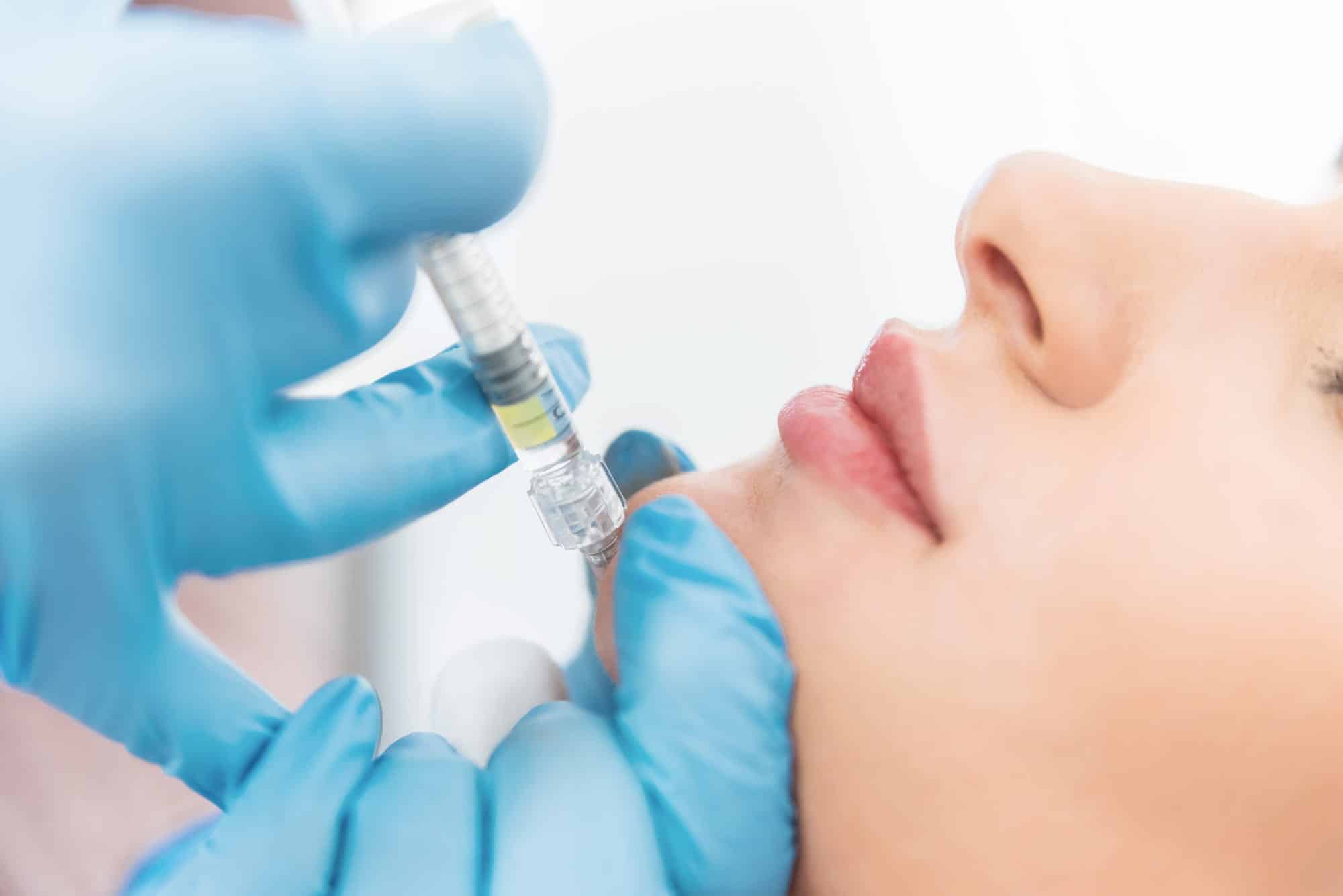
Filler injections in the chin compensate for the lack of volume in soft tissues, providing natural aesthetic lifting and anti-age effects.
However, the effect of chin augmentation isn’t permanent; the body will naturally break down the filler, and the results will gradually fade. This article explores this process and is dedicated to the factors influencing the longevity of chin fillers.
Understanding How Chin Fillers Work
Chin augmentation is indicated in the following cases:
- Insufficient chin size;
- Lack of clarity in the lower third of the face’s oval;
- Excessive fatty tissue in the chin area;
- Asymmetry;
- Slight chin displacement.
However, there are also certain contraindications for the procedure:
- Diabetes;
- Epilepsy;
- Infectious diseases;
- Inflammation processes at the injection site;
- Pregnancy and breastfeeding;
- Heightened sensitivity to filler components.
There are different types of fillers for the chin augmentation:
- HA-based fillers;
- Calcium hydroxyapatite fillers;
- Policaprolactone fillers;
- Polylactic acid fillers.
Fillers based on hyaluronic acid maintain volume by harnessing polymer, the water-attracting capabilities of molecules, and are considered the safest fillers to use. Biostimulant fillers have their efficacy in creating a framework through native collagen fibers. These chin fillers last longer than HA-based ones but have slightly higher risks of adverse effects.
The initial results are visible right after receiving chin filler injections, but the dermal filler will take some time to settle fully. Generally, it takes 1-2 weeks for the full integration with the surrounding tissues. During this time, any swelling or bruising will resolve, and the chin may slightly change shape and contour.
How Long Do Fillers Last in the Chin?
The type of filler used during the augmentation and its density have a major impact on the procedure:
- HA fillers generally last 6 to 18 months, depending on the specific product used and the patient’s characteristics.
- Calcium hydroxylapatite fillers – can last longer, up to 12-18 months.
- Polylactic acid fillers are the longest-lasting chin fillers. They stimulate collagen production, so the results can gradually appear over several months and last up to 2 years or more.
- Poly-L-Lactic acid fillers also stimulate collagen synthesis, ranging in longevity from 1 to 2 years.
Factors Influencing the Longevity of a Chin Filler
Except for the type of filler used, the longevity of chin fillers depends on several factors:
- Patients with a faster metabolism tend to break down fillers faster than those with a slower metabolism because their body’s natural enzymes are more active.
- Lifestyle choices, like smoking or sun exposure, can also speed up the breakdown of fillers as these activities damage collagen and elastin proteins that give skin its elasticity and structure.
- Certain medical conditions, like autoimmune disorders, can also affect the longevity of fillers.
Chin Filler Aftercare
After chin filler augmentation, it is important to follow a few simple steps to ensure long-lasting chin filler results and avoid complications:
- Avoid sleeping on the side or stomach for the first three days to reduce swelling and bruising.
- Do not massage or touch the injection area.
- Avoid alcohol and strenuous activity for at least a week following the procedure, as they can increase blood flow to the treated area and cause swelling.
- A cold compress can be applied to the chin area for 20 minutes several times a day to help reduce swelling and pain.
- Use a gentle cleanser and moisturizer to clean the area, and refrain from using harsh products that can irritate the skin.
It is essential to explain to the patient that everyone heals differently, and your instructions must be followed carefully. This will help to achieve the best possible results and avoid any complications.
Conclusion
The duration of chin augmentation results can vary based on many factors. Selecting the appropriate filler type, guided by a patient’s needs and goals, allows for achieving aesthetic harmony that ensures both satisfaction and safety of the patient.
FAQ
How often to get chin fillers?
The frequency of chin filler injections varies depending on the type of filler, the individual’s characteristics, and the desired results. Generally, the procedure must be repeated every 6 to 24 months to maintain the effect.
However, some factors that can shorten the chin filler’s longevity:
- Smoking and exposure to the sun can damage collagen and elastin, leading to the filler breaking down more quickly.
- Repeated facial expressions (such as smiling or frowning) can also speed up the breakdown of filler.
What happens when chin fillers wear off?
When chin fillers wear off, the treated area will gradually return to its pre-treatment appearance. This means that if the patient had the filler to correct a receding chin, the chin would start to recede again. Similarly, if they had the filler to plump up the chin, the chin would look flatter again.
In most cases, there are no adverse side effects when chin fillers wear off. However, sometimes, the filler may not be entirely absorbed by the body and may cause small bumps or lumps under the skin. These bumps can usually be dissolved with hyaluronidase.
Is 1mL of filler enough for the chin?
The amount of filler needed for the chin depends on the patient’s anatomy and desired results. Generally, 1mL of filler is enough to achieve subtle changes in the chin’s appearance. However, for a more dramatic change, you may need to inject more filler.
Factors that may affect how much filler the patient will need:
- The size of the chin;
- The desired results;
- The type of filler used (some fillers are more cohesive than others, meaning they retain their shape better).
Also, a skilled injector will be able to use the least amount of filler possible to achieve the desired results.
References
Chen B, Ma L, Wang J. Chin augmentation with hyaluronic acid: an injection technique based on anatomical morphology. Dermatologic Surgery. 2022;48(7):747-751. doi:10.1097/dss.0000000000003459.
Braz A, De Paula Eduardo CC. Reshaping the lower face using injectable fillers. Indian Journal of Plastic Surgery. 2020;53(02):207-218. doi:10.1055/s-0040-1716185.
Sykes JM, Fitzgerald R. Choosing the Best Procedure to Augment the Chin: Is Anything Better than an Implant? Facial Plastic Surgery. 2016;32(05):507-512. doi:10.1055/s-0036-1592162.
Vazirnia A, Braz A, Fabi S G. Nonsurgical jawline rejuvenation using injectable fillers. J Cosmet Dermatol. 2019;00:1–8.
Go B, Frost A, Friedman O. Using injectable fillers for chin and jawline rejuvenation. World Journal of Otorhinolaryngology – Head and Neck Surgery. 2023;9(2):131-137. doi:10.1002/wjo2.93.
Injectable aesthetics are popular due to their ability to provide noticeable results with minimal downtime compared to surgical procedures. They are versatile and can be tailored to meet individual aesthetic goals, whether it's enhancing lips, restoring facial volume, or smoothing out wrinkles. However, they should always be administered by qualified professionals to ensure safety and achieve optimal results.
Injectable aesthetics are used to enhance facial features, reduce the signs of aging, and improve overall facial symmetry and appearance.
Key types of injectable aesthetics include:
-
Dermal Fillers: These injectables are used to add volume, fill in wrinkles and folds, and enhance facial contours. They often contain substances like hyaluronic acid, collagen, or calcium hydroxylapatite, which help plump up the skin and smooth out fine lines and wrinkles.
-
Botulinum Toxin (Botox): Botulinum toxin injections temporarily relax facial muscles that cause wrinkles and lines to form. It is commonly used to treat forehead lines, frown lines between the eyebrows, and crow's feet around the eyes.
-
Collagen Stimulators: These injectables stimulate the body's own collagen production, helping to improve skin texture and firmness over time. Examples include poly-L-lactic acid (Sculptra) and calcium hydroxylapatite (Radiesse).
-
Neurotoxin Injections: Besides Botox, other neurotoxins such as Dysport and Xeomin are used similarly to reduce wrinkles and lines.





